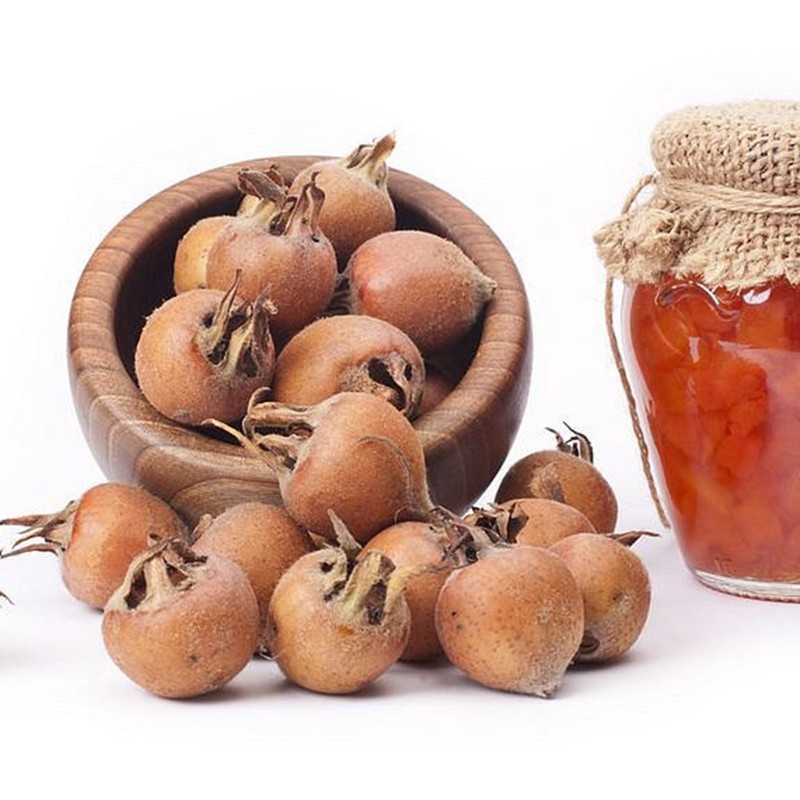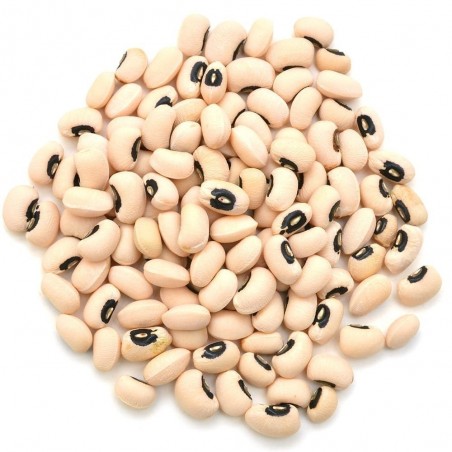
زعرور جرماني بذور
زعرور جرماني بذور
ثمن عبوة من 10 بذور.
الزعرور الجرماني أو الزعرور البستاني (ويعرف شعبيا بالزعرور البري) (باللاتينية: Crataegus germanica) نوع نباتي يتبع جنس الزعرور من الفصيلة الوردية.زعرور جرماني بذور
ثمن عبوة من 10 بذور.
الزعرور الجرماني أو الزعرور البستاني (ويعرف شعبيا بالزعرور البري) (باللاتينية: Crataegus germanica) نوع نباتي يتبع جنس الزعرور من الفصيلة الوردية.الموئل والانتشار
موطنه بلاد الشام وقبرص وتركيا والقوقاز واليونان وبلغاريا. يزرع أيضًا في المغرب العربي وفي مناطق من أوروبا.
Mespilus germanica, known as the medlar or common medlar, is a large shrub or small tree, and the name of the fruit of this tree. The fruit has been cultivated since Roman times, and is unusual in being available in winter, and in being eaten when 'bletted' (browned by rot). It is eaten raw and in a range of dishes.
Origins and related species
Despite its Latin name, which means German or Germanic medlar, it is indigenous to southwest Asia and also southeastern Europe, especially the Black Sea coasts of modern Turkey. It may have been cultivated for as long as 3000 years.
Until recently, Mespilus germanica was the only known species of the medlar. However, in 1990, a new species was discovered in North America, now named Mespilus canescens. The loquat, Eriobotrya japonica, is more distantly related than genera such as Crataegus, Amelanchier, Peraphyllum, and Malacomeles,[2] but was once thought to be closely related, and is still sometimes called the 'Japanese medlar'.
From an extensive study of literature and plant specimens, Kazimierz Borowicz concluded that the true homeland [of Mespilus germanica] is only in the south-eastern part of the Balkan peninsula, in Asia Minor, on the Caucasus, Crimea, northern Iran and possibly also in Turkmenia.
Description and ecology
Mespilus germanica requires warm summers and mild winters and prefers sunny, dry locations and slightly acidic soil. Under ideal circumstances, the deciduous plant grows up to 8 metres (26 ft) tall. Generally, it is shorter and more shrub-like than tree-like. With a lifespan of 30–50 years, the medlar tree is rather short-lived. Its bark is greyish brown with deep vertical cracks forming rectangular plates that tend to lift off. The leaves are dark green and elliptic, 8–15 centimetres (3.1–5.9 in) long and 3–5 centimetres (1.2–2.0 in) wide. The leaves are densely hairy (pubescent) below, and turn red in autumn before falling. It is found across Southern Europe where it is generally rare. It is reported to be naturalized in some woods in Southeast England, but is found in few gardens.[3]
The flowers have five broadly ovate white petals.[3] The flowers appear in late spring, are hermaphrodite, pollinated by bees, and self-fertile.[4] The flower is 6 centimetres (2.4 in) wide. The reddish-brown fruit is a pome, 2–3 centimetres (0.79–1.2 in) diameter, with wide-spreading persistent sepals around a central pit, giving a 'hollow' appearance to the fruit.
Cultivation and uses
The medlar was already being cultivated about three thousand years ago in the Caspian Sea region of northern Iran. It was introduced to Greece around 700 BC, and to Rome about 200 BC. It was an important fruit plant during Roman and medieval times. By the 17th and 18th century, however, it had been superseded by other fruits, and is little cultivated today. M. germanica pomes are one of the few fruits that become edible in winter, making it an important tree for gardeners who wish to have fruit available all year round. M. germanica plants can be grafted on to the rootstock of another species, for example the pear, quince, or hawthorn, to improve their performance in different soils.
Mespilus germanica fruits are hard, acidic, and high in bitter tannins. They become edible after being softened, 'bletted', by frost, or naturally in storage given sufficient time. Once softening begins the skin rapidly takes a wrinkled texture and turns dark brown, and the inside reduces to the consistency and flavour reminiscent of apple sauce. This process can confuse those new to medlars, as a softened fruit looks as if it has spoiled.
Once bletted, the fruit can be eaten raw, and are often eaten as a dessert, for example with cheese or tarts,[8] or used to make medlar jelly[9] and wine. Another dish is "medlar cheese", which is similar to lemon curd, being made with the fruit pulp, eggs, and butter. So-called medlar tea is usually not made from M. germanica but from wolfberry or goji, which is sometimes called "red medlar".
Cultivars of Mespilus germanica that are grown for their fruit include 'Hollandia', 'Nottingham', and 'Russian',[11] the large-fruited variety 'Dutch' (also known as 'Giant' or 'Monstrous'), 'Royal', 'Breda giant', and 'Large Russian'.
In Iran, the fruits, leaves, bark and wood of the tree have been used as medicines for ailments including diarrhoea, bloating of the stomach, throat abscesses and fever.
| Sowing Instructions | |
| Propagation: | |
| Pretreat - Scarification: | Seeds previously with sandpaper roughen then kept in water for 24 hours. |
|
Stratification: | 1. Keep Sowed seeds 2 weeks at room temperature (15-20 ˚ C). |
| Sowing Time: | all year round |
| Sowing Depth: | 1-3mm / Requires light for germination. |
| Sowing Mix: | Coir or sowing mix + sand or perlite |
| Germination temperature: | 20-25 ° C |
| Location: | bright + keep constantly moist not wet |
| Germination Time: | 2-8 weeks - few Months. |
| Watering: | Water regularly during the growing season |
|
|
|
| HEIRLOOM ? | Yes |
|---|---|
| بذور العضوية؟ | Organic Seeds |
| صالح للأكل؟ | Edible |
| المعالجة من بذر؟ | Soak in water before sowing 12-24 h Stratification needed: Yes |
| نبات معمر؟ | Perennial plant : Yes |
| مقاومة للبرودة والصقيع؟ | Cold resistant: to −30 °C |
| بذور منتقاة بعناية؟ | Handpicked seeds |
| الشركة المصنعة ؟ | Manufacturer: Seeds Gallery |
| أصل البذور؟ | Origin of Seeds: Serbia |
| بلد المنشأ من مجموعة متنوعة؟ | Variety from: Serbia |
| نبات طبي ؟ | Medicinal Plant: Yes |


Your review appreciation cannot be sent
Report comment
Report sent
Your report cannot be sent
اكتب تعليقك
Review sent
Your review cannot be sent
🌍 الشحن العالمي من الاتحاد الأوروبي
نقوم بالشحن إلى جميع أنحاء العالم من الاتحاد الأوروبي باستخدام بريد مسجل مع تأكيد استلام.
📦 تتبع الشحنة
لتتبع شحنتك، قم بتسجيل الدخول إلى حسابك، ثم اذهب إلى سجل الطلبات > التفاصيل وستجد رقم التتبع هناك.
التتبع العالمي: 17Track
لتتبع أرقام مثل RGxxxxxxHR: تتبع Posta.hr
🕒 يرجى الانتظار 24 ساعة على الأقل بعد الشحن لظهور معلومات التتبع.
⚠️ ملاحظات هامة
الدفع عند الاستلام غير متاح.
تحقق من مجلد البريد العشوائي/الغير هام في بريدك الإلكتروني للحصول على إشعارات الطلبات.
استخدم فقط نموذج الاتصال الموجود على موقعنا.
لن يتم الرد على الرسائل المرسلة مباشرة إلى بريدنا الإلكتروني.
📱 رقم الهاتف مطلوب
يرجى إدخال رقم هاتفك المحمول مع رمز البلد.
مثال: +966 512 345 678
🚚 شروط التوصيل
تتطلب الشحنات المسجلة توقيع المستلم.
لا تطلب إذا:
كنت تريد التسليم إلى صندوق بريد
لن تكون متواجداً لاستلام الطرد
تريد تسليمه إلى جار (❌ هذا غير ممكن)
📬 إذا أدخلت عنوان صندوق بريد وفُقدت الشحنة، فلن تكون مؤهلاً لاسترداد الأموال.
↩️ المرتجعات وإعادة الشحن
إذا تم إرجاع الشحنة إلينا لأي سبب:
سيتم فرض رسوم إرجاع 2 يورو
بالإضافة إلى تكلفة إعادة الشحن
⏱ التأخير والتتبع
إذا أظهر التتبع أن الشحنة لا تزال عند المرسل، فهذا يعني أنها في الطريق.
يرجى التواصل مع مكتب البريد المحلي باستخدام رقم التتبع.
نحن لسنا شركة بريدية ولا يمكننا تتبع الشحنات بالنيابة عنك.
لسنا مسؤولين عن مدة التوصيل.
🔍 يمكننا بدء تحقيق بفقدان الشحنة بعد مرور 30 يوماً على تاريخ الشحن فقط.
✈️ خيارات الشحن
| نوع الشحن | وقت المعالجة | تأمين | احتمال التأخير | ملاحظات |
|---|---|---|---|---|
| الشحن العادي | 7–10 أيام عمل | ❌ | 7–14 يومًا | الخيار الاقتصادي |
| شحن ذو أولوية | 1–7 أيام عمل | ❌ | 3–10 أيام | أولوية في المعالجة – لكن ليس بالضرورة أسرع شحن |
| شحن مؤمَّن | 1–7 أيام عمل | ✅ | 3–10 أيام | استرداد في حال فقدان الشحنة، متاح للطلبات حتى 150 يورو |
🕒 المدة التقديرية للتوصيل:
داخل الاتحاد الأوروبي: 3–20 يوم عمل
عالميًا: 5–30 يوم عمل
أمثلة للتوصيل إلى الولايات المتحدة: 27، 22، 19، 17، 13 يومًا
💳 طرق الدفع
💶 التحويل البنكي (SEPA / IBAN / SWIFT-BIC)
تأكد من كتابة رقم الطلب في تفاصيل التحويل (مثال: SGS-19811702).
في حال غياب المرجع، قد يتأخر تأكيد الدفع أو يتم إلغاء الطلب.
إذا لم يتم استلام الدفعة خلال 7 أيام، سيتم إلغاء الطلب تلقائيًا.
🅿️ PayPal
نقبل المدفوعات بـ اليورو فقط عبر PayPal.
يرجى تحويل العملة إلى اليورو أثناء عملية الدفع.
💳 الدفع بالبطاقة
الدفع يتم عبر موقعنا: Exotic Seeds Store
نقبل: Visa، MasterCard، American Express، Diners Club، UnionPay، JCB، Discover وغيرها.
💡 العميل يتحمل رسوم المعاملات البنكية إن وجدت.
يرجى تزويدنا بإثبات الدفع لتسريع معالجة طلبك.
📅 ملاحظات إضافية
لا نعالج الطلبات أو نقوم بالشحن أيام السبت والأحد.
يرجى دائمًا قراءة التنبيهات الهامة على موقعنا (مثل العطل الرسمية أو الشروط الخاصة).
📫 ملاحظة:
لا ترسل لنا رسائل على البريد الإلكتروني مباشرة. استخدم فقط نموذج الاتصال الموجود على موقعنا.
Related Products



















